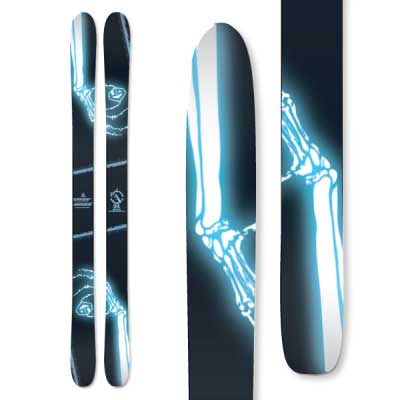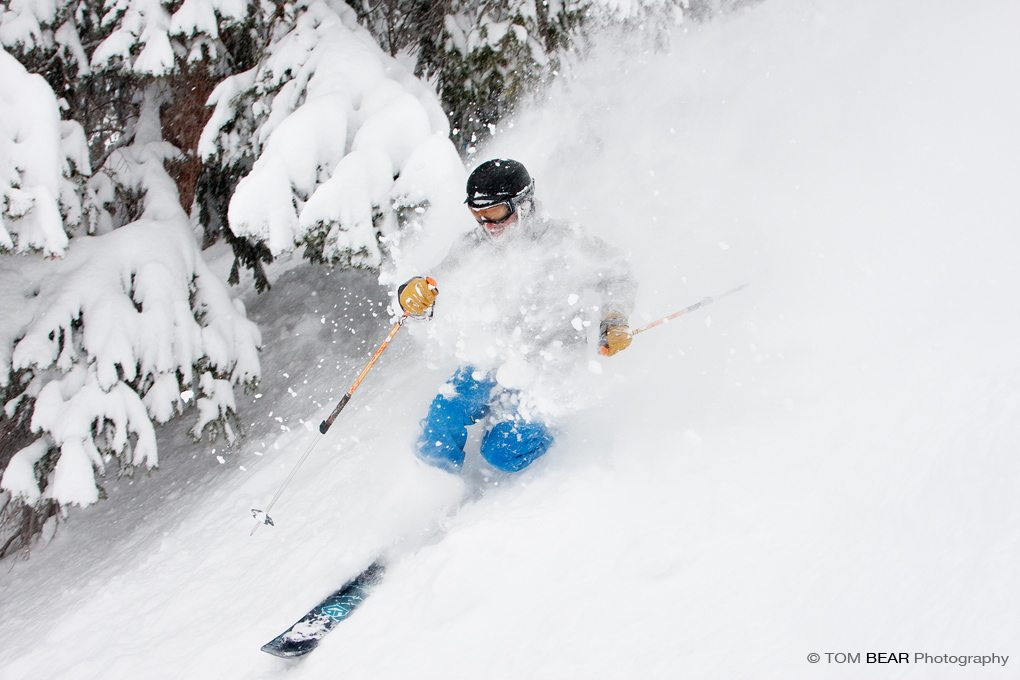 Ski: 2011-2012 Bluehouse Radius, 184cm
Ski: 2011-2012 Bluehouse Radius, 184cm
Dimensions (mm): 136-116-123
Turn Radius: 37 meters
Actual Tip-to-Tail Length (straight tape pull): 184cm
Skiable Edge: 147cm (7mm of camber)
Tip/Tail Rocker: 37cm (62mm of rise) / Flat Square Tail
Boots/Bindings: Scarpa TXComp / Rottefella NTN Freeride (Green Power Tubes)
Mount Location: -3.8cm from Traditional/Pow recommended (760mm from tail)
Test Location: Alta Ski Area
Days Skied: 10
Bluehouse is a Salt Lake City ski company with a reputation for making decent skis at a great price. By selling skis through their factory-direct web site, they hope to open up the sport to those who don’t want to drop more than $600 on a pair of boards. Most of their skis are made in China, with a few select models made in the Salt Lake warehouse.
To be honest, I was initially skeptical that I would find a ski in the Bluehouse quiver that would turn my head. But I did, and it’s called the Radius.
Bluehouse made just one size of the Radius this year, 184cm, and its name is seemingly a contradiction in terms. With a 37-meter turn radius and practically no side-cut, the Radius is one of the widest turning skis on the market. With 116mm underfoot and an effective edge of 147cm, this is a big ski built for speed and stability.
Bluehouse actually advertises the Radius as one of their telemark skis, stating their faith in the existence of the ripping freeheeler. The specs alone on this ski call for a powerful binding, so the Rotefella NTN seemed an obvious choice. Using an NTN binding, however, did introduce a few mounting issues. The factory recommendations for telemark mount points were for standard 75mm boots and bindings, which have a more forward mount placement because of 75mm boots’ duck bill and pivot point location.
As a very general rule, NTN bindings should be mounted at Alpine Boot Center -1cm, but in this case, it was even farther back. It took a few mount attempts to dial in a sweet spot, but I settled on boot center at 760mm from the tail, or -3.8 cm from factory recommended for Traditional/Pow (798mm from tail).
The Radius’ 7mm of camber can function like a slingshot when turning the ski. With this much camber, it is important to get your weight in the right place over the camber to control its springiness. With the binding too far back, I was drifting in my turns and having to speed check while the skis took me for a ride. Conversely, with the mount too far forward, my back ski was all over the place.
Once I dialed in the right spot to control the camber under foot, however, there was no chatter in the tips—ever—and riding the Radius was like riding a high-speed rail train while sipping tea. I never realized just how fast I was actually going because I felt so comfortably in control.
For a ski of this size, the Radius also gets on edge quickly and speeds up in the turn. I was able to get my back ski on edge easily, and, with the support of the tails, the front ski was completely stable. Carving the steepest hard-packed groomers with the most confidence I’ve felt yet as a tele skier, I found myself passing the fixed heelers on Alta’s Schusses Face. The Radius was the fastest ski on the mountain that day.

But the Radius doesn’t excel only on groomers. Thirty-seven centimeters of early rise in the tip, flat tails, and a stiff flex translate to some of the best powder skiing I’ve experienced. Actually, “hauling ass through powder” is a better way to describe the experience. This ski never liked to go slow, and riding waist-deep pow in Thirds on Alta’s backside at mach speed was some of the best times I’ve had this season. Even with such stiff, flat tails, the Radius floated effortlessly, and the tips never dove. It was also surprisingly easy to slash turns in the deeper snow.

Bluehouse skis are known for a lack of durability and Bluehouse uses extruded bases to cut costs. I think most ski manufacturers out there today make at least one or two nice products, but Bluehouse skis are cheap because they’re built cheaply, not just because they only sell direct.
There are better ways to save a couple of bucks on new skis.
Maciej, Thanks for expressing your concern. But the Radius actually has a sintered base, NOT an extruded base. There have been issues with durability and binding pullouts in the past with Bluehouse, but they seem to be stepping up their game. I’ve only ridden the Radius 12 days now, and I’ll be putting more time in on them. So far, the binding mount is bomber – no screws have slipped or moved. I will definitely report back if something pulls out, or if there seem to be durability issues with the Radius.
Robin,
It’s good to hear that Bluehouse are stepping up their game. These skis have a similar shape (and based on your description) ride to my personal faves, 4FRNT EHP’s. If these skis rip that hard AND hold up well, they’ll be an awesome all-purpose ski-tele or alpine, in-bounds or in the backcounty. I look forward to a follow-up review after they’ve been hammered for a few dozen days.
While they do seem somewhat less durable than my other skis, I have to say that the maestros are a ripping’ ski that performs great in the powder, blasts the crud, and even handles bumps respectably well. Unless they are hard, in which case they wander a bit. I still think they are a great deal for the money, we’ll see how they make it through next season.
Hi
I’m curious about how this ski would be for freeride comps and steep billygoating, too much camber? I’m a fan of straight skis too.
Kai,
I don’t think too much camber would be an issue for billygoating, if anything it would help to load the flat tails and give you a boost. But the Radius doesn’t have the best swing weight nor the shortest turn radius. I think the bottom line on this ski is its great for ripping wide open faces. I’d look for something a little more versatile for comps.
The mount point really sounds a long way back! I have a pair I am due to mount up … thinking about mounting at 80cm boot centre from tail